GO doc tutorial
info
Here are my examples to what is possible with Go Doc syntax explained here.
Quotes

// “A pair of consecutive backticks (` U+0060) is interpreted as a Unicode left quote (“ U+201C),
// and a pair of consecutive single quotes (' U+0027) is interpreted as a Unicode right quote (” U+201D).”
func Quotes() {}
Headings

// Some text must have empty line after for the heading to work
//
// # Some Heading
//
// Some text must have empty line before for the heading to work
func Heading() {}
Links

// Package json implements encoding and decoding of JSON as defined in
// [RFC 7159]. The mapping between JSON and Go values is described
// in the documentation for the Marshal and Unmarshal functions.
//
// For an introduction to this package, see the article
// “[JSON and Go].”
//
// [RFC 7159]: https://tools.ietf.org/html/rfc7159
// [JSON and Go]: https://golang.org/doc/articles/json_and_go.html
func Links() {}
Doc Links

// ReadFrom reads data from r until EOF and appends it to the buffer, growing
// the buffer as needed. The return value n is the number of bytes read. Any
// error except [io.EOF] encountered during the read is also returned. If the
// buffer becomes too large, ReadFrom will panic with [ErrTooLarge].
func DocLinks() {}
Lists

// PublicSuffixList provides the public suffix of a domain. For example:
// - the public suffix of "example.com" is "com",
// - the public suffix of "foo1.foo2.foo3.co.uk" is "co.uk", and
// - the public suffix of "bar.pvt.k12.ma.us" is "pvt.k12.ma.us".
//
// Implementations of PublicSuffixList must be safe for concurrent use by
// multiple goroutines.
func Lists() {}
Numbered Lists
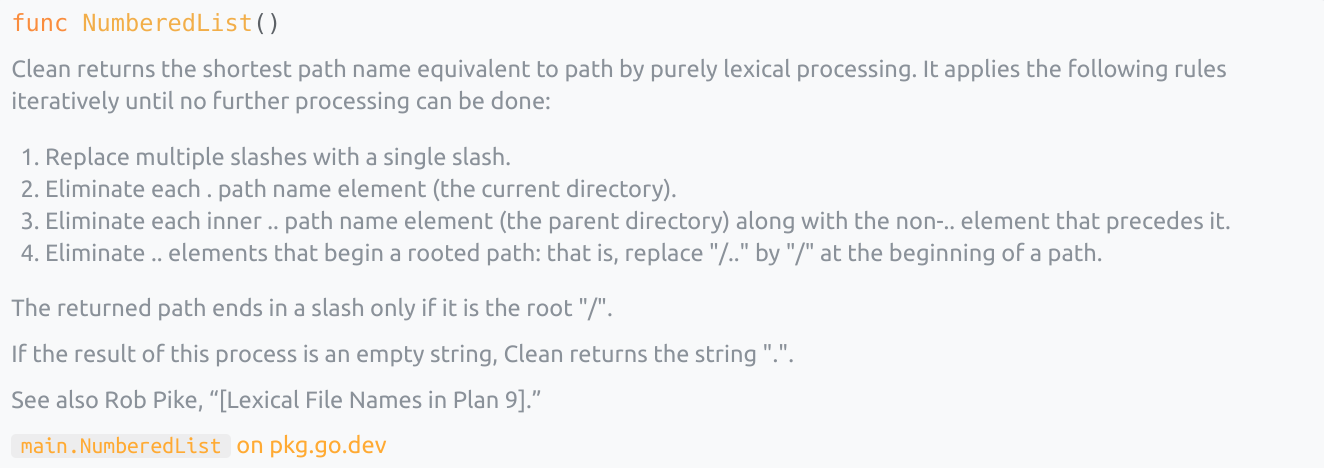
// Clean returns the shortest path name equivalent to path
// by purely lexical processing. It applies the following rules
// iteratively until no further processing can be done:
//
// 1. Replace multiple slashes with a single slash.
// 2. Eliminate each . path name element (the current directory).
// 3. Eliminate each inner .. path name element (the parent directory)
// along with the non-.. element that precedes it.
// 4. Eliminate .. elements that begin a rooted path:
// that is, replace "/.." by "/" at the beginning of a path.
//
// The returned path ends in a slash only if it is the root "/".
//
// If the result of this process is an empty string, Clean
// returns the string ".".
//
// See also Rob Pike, “[Lexical File Names in Plan 9].”
func NumberedList() {}
Lists with Sub Items
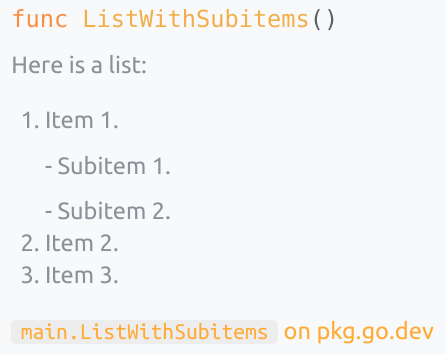
// Here is a list:
//
// 1. Item 1.
//
// - Subitem 1.
//
// - Subitem 2.
//
// 2. Item 2.
//
// 3. Item 3.
func ListWithSubitems() {}
Code Blocks
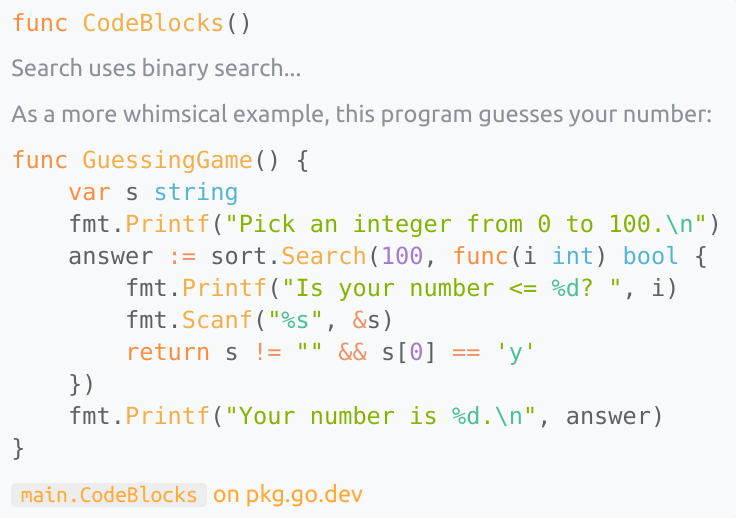
// Search uses binary search...
//
// As a more whimsical example, this program guesses your number:
//
// func GuessingGame() {
// var s string
// fmt.Printf("Pick an integer from 0 to 100.\n")
// answer := sort.Search(100, func(i int) bool {
// fmt.Printf("Is your number <= %d? ", i)
// fmt.Scanf("%s", &s)
// return s != "" && s[0] == 'y'
// })
// fmt.Printf("Your number is %d.\n", answer)
// }
func CodeBlocks() {}
Code blocks 2
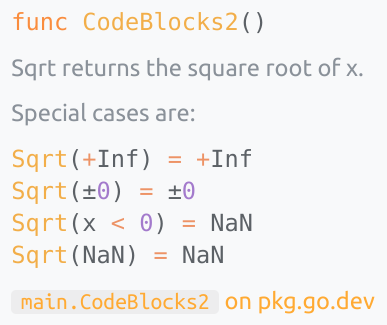
// Sqrt returns the square root of x.
//
// Special cases are:
//
// Sqrt(+Inf) = +Inf
// Sqrt(±0) = ±0
// Sqrt(x < 0) = NaN
// Sqrt(NaN) = NaN
func CodeBlocks2() {}
Preformatted text
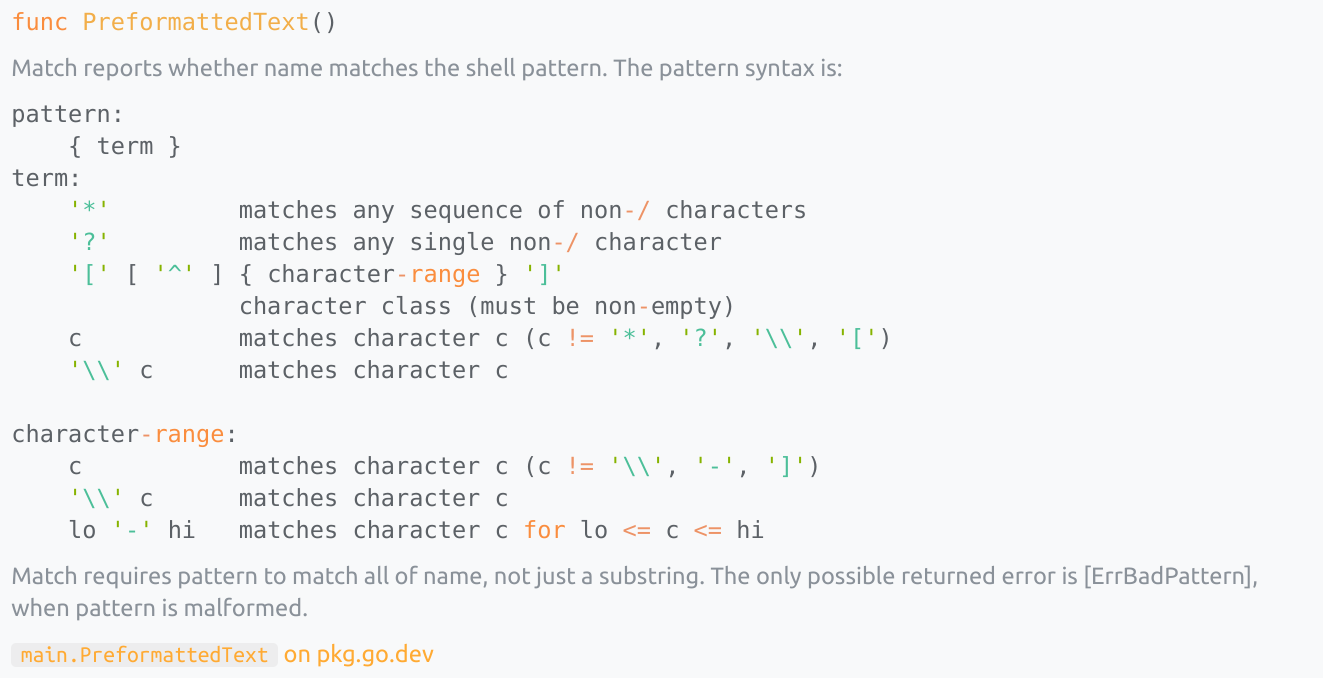
// Match reports whether name matches the shell pattern.
// The pattern syntax is:
//
// pattern:
// { term }
// term:
// '*' matches any sequence of non-/ characters
// '?' matches any single non-/ character
// '[' [ '^' ] { character-range } ']'
// character class (must be non-empty)
// c matches character c (c != '*', '?', '\\', '[')
// '\\' c matches character c
//
// character-range:
// c matches character c (c != '\\', '-', ']')
// '\\' c matches character c
// lo '-' hi matches character c for lo <= c <= hi
//
// Match requires pattern to match all of name, not just a substring.
// The only possible returned error is [ErrBadPattern], when pattern
// is malformed.
func PreformattedText() {}
Pretty JSON
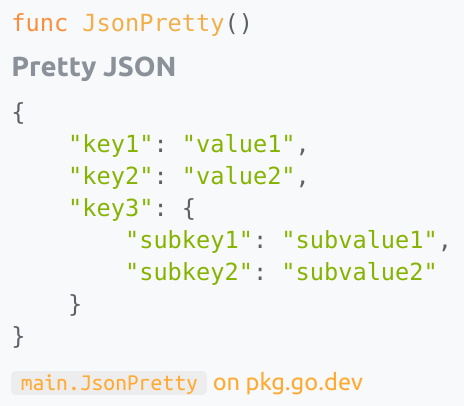
/*
# Pretty JSON
{
"key1": "value1",
"key2": "value2",
"key3": {
"subkey1": "subvalue1",
"subkey2": "subvalue2"
}
}
*/
func JsonPretty() {}
Example function flow
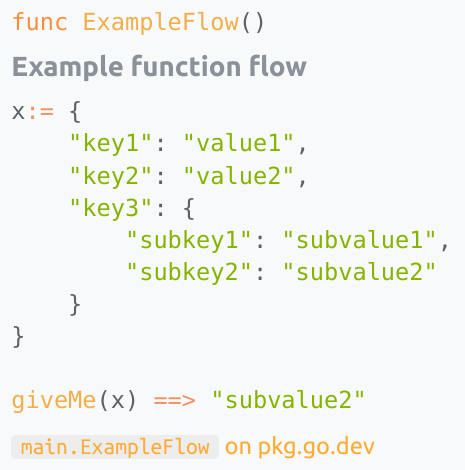
/*
# Example function flow
x:= {
"key1": "value1",
"key2": "value2",
"key3": {
"subkey1": "subvalue1",
"subkey2": "subvalue2"
}
}
giveMe(x) ==> "subvalue2"
*/
func ExampleFlows() {}